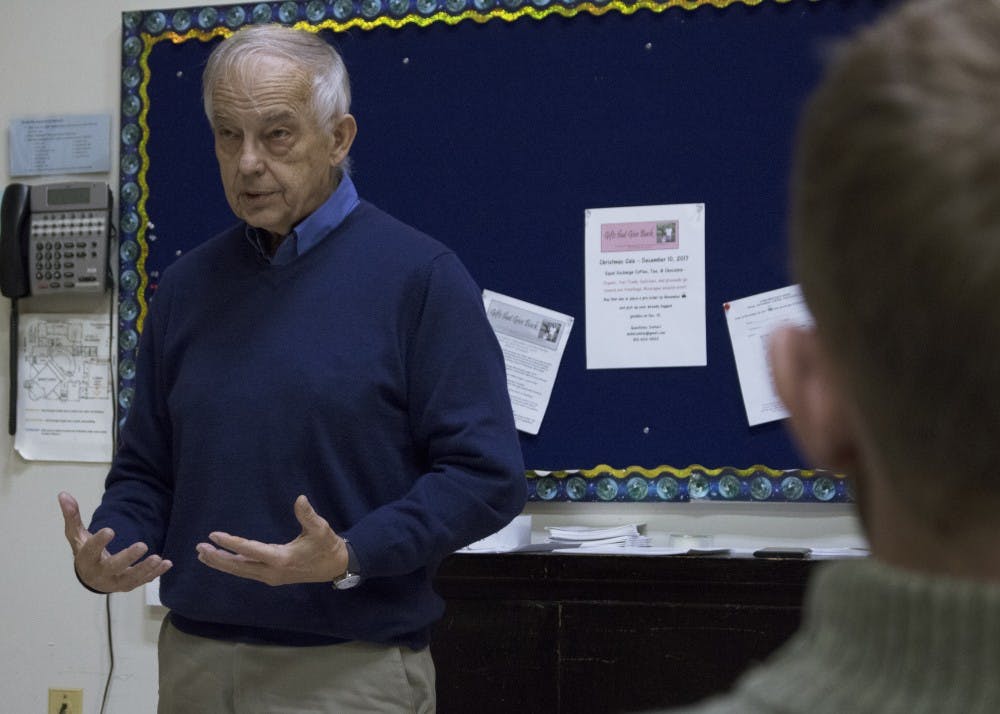The Interfaith Emergency Winter Shelter is completely run by volunteers. But the shelter still needs 150 more volunteers for winter to make sure they can help all who may need it.
Last winter, the coldest day in Bloomington had a low of minus 4 degrees and an average wind speed of eight mph. In those kinds of conditions, frostbite can set in within 30 minutes, according to the National Weather Service.
At the Interfaith Emergency Winter Shelter on West 3rd Street and South Westplex Avenue, volunteers help keep people who are homeless in Bloomington out of those dangerous conditions.
“The mission of the Interfaith Winter Shelter is to provide a warm safe place for people to sleep for people who need it during the winter," said former shelter board president Dann Watts, 74.
In the past, the shelter has operated out of five different locations throughout the week. This year, the shelter has found a permanent space at Wheeler Mission, a ministry that provides services to the homeless.
Watts said the move has made it easier for guests and volunteers to locate the shelter, allows them to consolidate supplies and better link guests to other services in Bloomington.
“It's somewhat complicated when someone new says 'I want to go to the shelter,' and you have to tell them, 'If it's Monday it's here, if it's Wednesday here.’ When it's all in one location, it's easier,” Watts said.
Already this fall, temperatures have dipped below freezing. The season for Interfaith Emergency Winter Shelter began Nov. 1, and Watts said they are receiving around 35 guests a night. As of Tuesday, the shelter had 340 volunteers, but Watts said more are needed.
“At the moment, we probably need another 150 volunteers. That would make things run much more smoothly,” Watts said.
At 7:30 p.m. Tuesday, in classroom seven of the First Presbyterian Church, Watts held a training session for new volunteers. Seven people, most of them IU students, came to learn more about the shelter and how to get involved.
Watts said that last year, 150 IU students volunteered at the shelter.
Jennie Moser, a graduate student at IU, sings in the church choir at First United Church. She said she came because the church encouraged her to volunteer at the shelter last winter.
Moser said that she wants to volunteer at the shelter because she can provide for those who can't provide for themselves.
“There’s no reason I can’t skip an episode of Netflix to do something more productive,” Moser said.
Watts said training is an overstretched word to describe how he prepares volunteers for shifts at the shelter. Watts offered background information on the shelter, described the five different shifts and tried to give volunteers an idea of what a typical night in the shelter looks like.
Watts said that one of the most important things the shelter does is encourage volunteers to interact with guests.
“It sort of sets the tone for what we're trying to achieve, that this is a friendly place, and we value everybody as individuals,” Watts said. “We want to be friendly, and volunteers are important for that.”
Watts said that the first shift, from about 7:30 to 11:30 p.m., where volunteers help get guests registered for the night and eat dinner, is when volunteers have the best opportunity to interact with guests.
During registration, guests are asked a few demographic questions and put their belongings away for the night to reduce theft in the shelter. Guests also go through a weapons screening to ensure the safety of all guests.
From 8 to 10:30 p.m., a separate kitchen shift prepares and serves soup or sandwiches to the guests for dinner.
The second shift runs from 11:30 p.m. to 2:30 a.m. Watts said volunteers are there during that time in case something happens. If a fire alarm goes off, volunteers need to be there to make sure everyone exits the building. Watts said volunteers are typically able to read during this time or use their Wi-Fi.
The third shift goes from 2:30 to 5 a.m. Volunteers do much of the same work as the second shift, but they are responsible for making coffee toward the end of their shift.
The fourth shift starts at 6 a.m. Volunteers clean up the shelter by putting bedding in laundry bags and cleaning mattresses, mats and pillows.
Altogether, the shelter requires 20-25 volunteers a night.
Lynne Foster Shifriss, current board member and volunteer, said she completed her first shift Nov. 1 from 2:45 a.m. to 6 a.m.
In an email, Shifriss said she was nervous before going to volunteer, but it turned out to be OK.
“Quiet and peaceful here,” Shifriss posted on Facebook about that first night. "The guests are mostly really grateful and polite. Most are still sleeping; a few are up reading or talking.”
Shifriss said in the email a friend commented and said most are afraid to help.
Another friend assured the commenter multiple volunteers and site directors are on site who are trained and present to handle anything out of the ordinary.
"Mostly, I knitted and chatted with another volunteer," Shifriss posted on Facebook. "One guy wanted to leave early; we got his bag of belongings and gave it to him. One person needed my help to get into her bag of belongings and get her prescription medication."
At the training session, Watts said most nights are quiet and peaceful but acknowledged incidents do happen.
“Most of the guests actually verbalize the fact that they're very grateful to volunteers and individual people for coming out and helping them,” Watts said. “So, it's not just masses of people who come in and leave without saying a word. They really are appreciative, and they really say that.”




